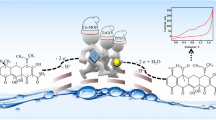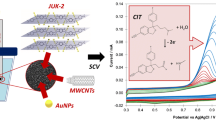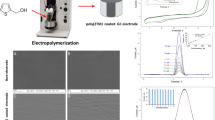Abstract
Sensitive determination of ofloxacin (OFL) is very essential for human health and environmental protection. Here, a novel composite of gold nanoparticles(nAu)@MXene(Ti3C2Tx)/poly-p-aminobenzene sulfonic acid (PABSA) was fabricated on the surface of glassy carbon electrode (GCE) and used to sensitively determine OFL. The results of experiments showed that the obtained nAu@Ti3C2Tx/PABSA/GCE electrode could be used as an electrochemical sensor to directly detect ofloxacin (OFL) by differential pulse voltammetry (DPV). Under the optimal conditions, the proposed electrode displayed a broader linear range and a lower detection limit (LOD) for OFL determination when it was compared to those similar sensors. The linear range was from 5.0 × 10−8 to 5.0 × 10−4 mol/L and the LOD was 3.7 × 10−8 mol/L (S/N = 3). The nAu@Ti3C2Tx/PABSA/GCE electrode also showed good selectivity, repeatability, and reproducibility. Finally, the proposed electrode was used to detect OFL in commercial samples by the standard addition method. The obtained recovery was from 97.3% and 105.7% showing its potential applications in actual sample analysis.
Graphical Abstract






Similar content being viewed by others
References
Ding C, Guo J, Chen P, Gan W, Yin Z, Qi S, et al. All-solid-state Z-scheme In2S3/CQDs/TiO2 heterojunction for highly efficient degradation of ofloxacin. Appl Surf Sci. 2022;596:153629. https://doi.org/10.1016/j.apsusc.2022.153629.
Sullivan MV, Henderson A, Hand RA, Turner NW. A molecularly imprinted polymer nanoparticle-based surface plasmon resonance sensor platform for antibiotic detection in river water and milk. Anal Bioanal Chem. 2022;414(12):3687–96. https://doi.org/10.1007/s00216-022-04012-8.
Su Q, Li J, Yuan H, Wang B, Wang Y, Li Y, et al. Visible-light-driven photocatalytic degradation of ofloxacin by g-C3N4/NH2-MIL-88B(Fe) heterostructure: mechanisms, DFT calculation, degradation pathway and toxicity evolution. Chem Eng J. 2022;427:131594. https://doi.org/10.1016/j.cej.2021.131594.
Feng R, Zhang X, Xue X, Xu Y, Ding H, Yan T, et al. [Ru(bpy)3](2+)@Ce-UiO-66/Mn:Bi2S3 heterojunction and its exceptional photoelectrochemical aptasensing properties for ofloxacin detection. ACS Appl Bio Mater. 2021;4(9):7186–94. https://doi.org/10.1021/acsabm.1c00749.
Chen P, Blaney L, Cagnetta G, Huang J, Wang B, Wang Y, et al. Degradation of ofloxacin by perylene diimide supramolecular nanofiber sunlight-driven photocatalysis. Environ Sci Technol. 2019;53(3):1564–75. https://doi.org/10.1021/acs.est.8b05827.
Zhang Z, Huang L, Sheng S, Jiang C, Wang Y. MIL-125(Ti)-derived COOH functionalized TiO2 grafted molecularly imprinted polymers for photoelectrochemical sensing of ofloxacin. Sens Actuators B-Chem. 2021;343:130119. https://doi.org/10.1016/j.snb.2021.130119.
Yan Z, Yi H, Wang L, Zhou X, Yan R, Zhang D, et al. Fluorescent aptasensor for ofloxacin detection based on the aggregation of gold nanoparticles and its effect on quenching the fluorescence of Rhodamine B. Spectrochim Acta A Mol Biomol Spectrosc. 2019;221:117203. https://doi.org/10.1016/j.saa.2019.117203.
Zhou X, Wang L, Shen G, Zhang D, Xie J, Mamut A, et al. Colorimetric determination of ofloxacin using unmodified aptamers and the aggregation of gold nanoparticles. Microchim Acta. 2018;185(7):355. https://doi.org/10.1007/s00604-018-2895-2.
Koska I, Purgat K, Glowacki R, Kubalczyk P. Simultaneous determination of ciprofloxacin and ofloxacin in animal tissues with the use of capillary electrophoresis with transient pseudo-isotachophoresis. Molecules. 2021;26(22):6931. https://doi.org/10.3390/molecules26226931.
Luan F, Wang Y, Zhang S, Zhuang X, Tian C, Fu X, et al. Facile synthesis of a cyclodextrin-metal organic framework decorated with Ketjen Black and platinum nanoparticles and its application in the electrochemical detection of ofloxacin. Analyst. 2020;145(5):1943–9. https://doi.org/10.1039/C9AN02575H.
Chai H, Ma X, Sun H, Miao P. DNA-MnO2 nanoconjugates investigation and application for electrochemical polymerase chain reaction. Anal Chem. 2022;94(11):4565–9. https://doi.org/10.1021/acs.analchem.1c04844.
Meng F, Sun H, Huang Y, Tang Y, Chen Q, Miao P. Peptide cleavage-based electrochemical biosensor coupling graphene oxide and silver nanoparticles. Anal Chim Acta. 2019;1047:45–51. https://doi.org/10.1016/j.aca.2018.09.053.
Shimada T, Takenaka N, Ando Y, Otani M, Okubo M, Yamada A. Relationship between electric double-layer structure of MXene electrode and its surface functional groups. Chem Mater. 2022;34(5):2069–75. https://doi.org/10.1021/acs.chemmater.1c03328.
Das P, Ganguly S, Saha A, Noked M, Margel S, Gedanken A. Carbon-dots-initiated photopolymerization: an in situ synthetic approach for MXene/poly(norepinephrine)/copper hybrid and its application for mitigating water pollution. ACS Appl Mater Interfaces. 2021;13(26):31038–50. https://doi.org/10.1021/acsami.1c08111.
Mathew M, Rout CS. Electrochemical biosensors based on Ti3C2Tx MXene: future perspectives for on-site analysis. Curr Opin Electrochem. 2021;30:100782. https://doi.org/10.1016/j.coelec.2021.100782.
Sardana S, Kaur H, Arora B, Aswal DK, Mahajan A. Self-powered monitoring of ammonia using an MXene/TiO2/Cellulose nanofiber heterojunction-based sensor driven by an electrospun triboelectric nanogenerator. ACS Sens. 2022;7(1):312–21. https://doi.org/10.1021/acssensors.1c02388.
Hu K, Cheng J, Wang K, Zhao Y, Liu Y, Yang H, et al. Sensitive electrochemical immunosensor for CYFRA21-1 detection based on AuNPs@MoS2@Ti3C2Tx composites. Talanta. 2022;238(Pt 1):122987. https://doi.org/10.1016/j.talanta.2021.122987.
Guo W, Surya SG, Babar V, Ming F, Sharma S, Alshareef HN, et al. Selective toluene detection with Mo2CTx MXene at room temperature. ACS Appl Mater Interfaces. 2020;12(51):57218–27. https://doi.org/10.1021/acsami.0c16302.
Gao L, Li C, Huang W, Mei S, Lin H, Ou Q, et al. MXene/polymer membranes: synthesis, properties, and emerging applications. Chem Mater. 2020;32(5):1703–47. https://doi.org/10.1021/acs.chemmater.9b04408.
Han L, Zhao Y, Chang C, Li F. A novel electrochemical sensor based on poly(p-aminobenzene sulfonic acid)-reduced graphene oxide composite film for the sensitive and selective detection of levofloxacin in human urine. J Electroanal Chem. 2018;817:141–8. https://doi.org/10.1016/j.jelechem.2018.04.008.
Li S, Zhong T, Long Q, Huang C, Chen L, Lu D, et al. A gold nanoparticles-based molecularly imprinted electrochemical sensor for histamine specific-recognition and determination. Microchem J. 2021;171:106844. https://doi.org/10.1016/j.microc.2021.106844.
Xi L, Zhang D, Wang F, Huang Z, Ni T. Layer-by-layer assembly of poly(p-aminobenzene sulfonic acid)/quaternary amine functionalized carbon nanotube/ p -aminobenzene sulfonic acid composite film on glassy carbon electrode for the determination of ascorbic acid. J Electroanal Chem. 2016;767:91–9. https://doi.org/10.1016/j.jelechem.2016.01.015.
Daniel MC, Astruc D. Gold nanoparticles: assembly, supramolecular chemistry, quantum-size-relat ed properties, and applications toward biology, catalysis, and nanotechnology. Chem. Rev. 2004;104(1):293–346. https://doi.org/10.1021/cr030698+.
Lopez DN, Galante M, Alvarez EM, Risso PH, Boeris V. Physicochemical study of mixed systems composed by bovine caseinate and the galactomannan from Gleditsia amorphoides. Carbohydr Polym. 2017;173:1–6. https://doi.org/10.1016/j.carbpol.2017.05.044.
Wang L, Zheng W, Li S, Zhong L, Jiang X. Aminophenol-decorated gold nanoparticles for curing bacterial infections. Nano Lett. 2022;22(9):3576–82. https://doi.org/10.1021/acs.nanolett.1c04968.
Xu Y, Wang X, Ding C, Luo X. Ratiometric antifouling electrochemical biosensors based on multifunctional peptides and MXene loaded with Au nanoparticles and methylene blue. ACS Appl Mater Interfaces. 2021;13(17):20388–96. https://doi.org/10.1021/acsami.1c04933.
Wu Z, Sun DW, Pu H, Wei Q, Lin X. Ti3C2Tx MXenes loaded with Au nanoparticle dimers as a surface-enhanced Raman scattering aptasensor for AFB1 detection. Food Chem. 2022;372:131293. https://doi.org/10.1016/j.foodchem.2021.131293.
Zheng Z, Wu W, Yang T, Wang E, Du Z, Hou X, et al. In situ reduced MXene/AuNPs composite toward enhanced charging/discharging and specific capacitance. J Adv Ceram. 2021;10(5):1061–71. https://doi.org/10.1007/s40145-021-0491-0.
Wang Y, Zeng Z, Qiao J, Dong S, Liang Q, Shao S. Ultrasensitive determination of nitrite based on electrochemical platform of AuNPs deposited on PDDA-modified MXene nanosheets. Talanta. 2021;221:121605. https://doi.org/10.1016/j.talanta.2020.121605.
Zhou R, Tu B, Xia D, He H, Cai Z, Gao N, et al. High-performance Pt/Ti3C2Tx MXene based graphene electrochemical transistor for selective detection of dopamine. Anal Chim Acta. 2022;1201:339653. https://doi.org/10.1016/j.aca.2022.339653.
Tang YY, Chen PY. Gold nanoparticle-electrodeposited electrodes used for p-nitrophenol detection in acidic media: effect of electrodeposition parameters on particle density, size distribution, and electrode performance. J Chin Chem Soc. 2011;58:723–31. https://doi.org/10.1002/jccs.201190114.
Bathinapatla A, Kanchi S, Singh P, Sabela MI, Bisetty K. Fabrication of copper nanoparticles decorated multiwalled carbon nanotubes as a high performance electrochemical sensor for the detection of neotame. Biosens Bioelectron. 2015;67:200–7. https://doi.org/10.1016/j.bios.2014.08.017.
Wong A, Silva TA, Vicentini FC, Fatibello-Filho O. Electrochemical sensor based on graphene oxide and ionic liquid for ofloxacin determination at nanomolar levels. Talanta. 2016;161:333–41. https://doi.org/10.1016/j.talanta.2016.08.035.
Wu F, Xu F, Chen L, Jiang B, Sun W, Wei X. Cuprous oxide/nitrogen-doped graphene nanocomposites as electrochemical sensors for ofloxacin determination. Chem Res Chin Univ. 2016;32(3):468–73. https://doi.org/10.1007/s40242-016-5367-4.
Zhu Y, Li C, Wang L, Chen M, Yu J, Liu Q, et al. Differential pulse voltammetry determination of ofloxacin in human serum and urine based on a novel tryptophan-graphene oxide-carbon nanotube electrochemical sensor. Electroanalysis. 2019;31(8):1429–36. https://doi.org/10.1002/elan.201900036.
Khorablou Z, Shahdost-Fard F, Razmi H. Flexible and highly sensitive methadone sensor based on gold nanoparticles/polythiophene modified carbon cloth platform. Sens Actuators B-Chem. 2021;344:130284. https://doi.org/10.1016/j.snb.2021.130284.
Akbari S, Jahani S, Foroughi MM, Hassani NH. Simultaneous determination of methadone and morphine at a modified electrode with 3D beta-MnO2 nanoflowers: application for pharmaceutical sample analysis. RSC Adv. 2020;10(63):38532–45. https://doi.org/10.1039/D0RA06480G.
Lang J, Wang W, Zhou Y, Guo D, Shi R, Zhou N. Electrochemical behavior and direct quantitative determination of paclitaxel. Front Chem. 2022;10:834154. https://doi.org/10.3389/fchem.2022.834154.
Huang K-J, Liu X, Xie W-Z, Yuan H-X. Voltammetric behavior of ofloxacin and its determination using a multi-walled carbon nanotubes-Nafion film coated electrode. Microchim Acta. 2008;162(1–2):227–33. https://doi.org/10.1007/s00604-008-0943-z.
Zhang F, Gu S, Ding Y, Zhang Z, Li L. A novel sensor based on electropolymerization of beta-cyclodextrin and L-arginine on carbon paste electrode for determination of fluoroquinolones. Anal Chim Acta. 2013;770:53–61. https://doi.org/10.1016/j.aca.2013.01.052.
Manjula N, Pulikkutty S, Chen T-W, Chen S-M, Liu X. Hexagon prism-shaped cerium ferrite embedded on GC electrode for electrochemical detection of antibiotic drug ofloxacin in biological sample. Colloids Surf, A. 2021;627:127129. https://doi.org/10.1016/j.colsurfa.2021.127129.
Funding
This work was supported by the Nature Science Foundation of Liaoning Province (No. 2021-MS-273), Liaoning BaiQianWan Talents Program (No. 2020921109), High-end Research Incubation Scheme of Liaoning Normal University (No. GD20L001), and National College Students Innovation and Entrepreneurship Training Program (No. 202210165027).
Author information
Authors and Affiliations
Contributions
Zuan Yang: data curation, writing—original draft preparation. Jing Hu: data curation, writing—original draft preparation. Xiaoyu Zhang: data curation, writing—original draft preparation. Huimin Yang: formal analysis, writing—reviewing and editing. Peiran Meng: formal analysis, writing—reviewing and editing. Huanying Zhao: formal analysis, writing—reviewing and editing. Yue Sun: conceptualization, methodology.
Corresponding author
Ethics declarations
Conflict of interest
The authors declare no competing interests.
Additional information
Publisher's note
Springer Nature remains neutral with regard to jurisdictional claims in published maps and institutional affiliations.
Supplementary Information
Below is the link to the electronic supplementary material.
Rights and permissions
Springer Nature or its licensor (e.g. a society or other partner) holds exclusive rights to this article under a publishing agreement with the author(s) or other rightsholder(s); author self-archiving of the accepted manuscript version of this article is solely governed by the terms of such publishing agreement and applicable law.
About this article
Cite this article
Yang, Z., Hu, J., Zhang, X. et al. MXene-based composites as an electrochemical sensor for ultrasensitive determination of ofloxacin. Anal Bioanal Chem 415, 157–166 (2023). https://doi.org/10.1007/s00216-022-04402-y
Received:
Revised:
Accepted:
Published:
Issue Date:
DOI: https://doi.org/10.1007/s00216-022-04402-y




